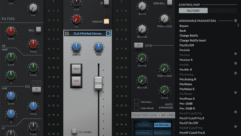
Installation Profile: AV Update
Nov 1, 2008 12:00 PM,
By Dan Daley
Architectural firm RTKL redesigns the U.S. Naval Academy’s historic mess hall with flexible AV.

Working with viewing-angle studies using the 8X rule, architectural firm RTKL initially suggested placing Sharp PN-455P 45in. LCD screens along the wall of each of the three 250ft. wings of King Hall—the 4,800-seat dining space at the U.S. Naval Academy in Annapolis, Md.—so that the furthest viewer would be no more than eight times the height of the image away from the image. However, due to the low ceiling height of the wings and considering that the content would only be for casual-viewing purposes, RTKL increased the rule to 16X. This allowed the team to space the displays out more and reduce the overall number of displays needed. The displays are supported with Chief Manufacturing PCM-2045 mounts that are attached to the structure above the finished ceiling.
When the U.S. Naval Academy in Annapolis, Md., graduated its first class in 1854, semaphore flags were the primary means sailors used for long-distance communication. Most cadets at the academy had likely never even seen a telegraph, which had only gone into commercial use barely a decade earlier. Those cadets would be surprised to see the academy’s venerable King Hall today — a 4,800-seat dining space that can literally accommodate the school’s entire 4,400-member student body and most faculty at the same sitting. As of earlier this year, thanks to a state-of-the-art renovation of the vintage space, all of them can now watch entertainment and informational programming on 74 45in. LCD screens positioned throughout the hall’s central section and the three 250ft.-long wings that emanate from it — so long and low that semaphore could still make sense as a backup system inside the hall.
Thanks to a zoned distribution system for audio and video, the space can also be divided into three separate large classrooms that can accommodate groups of several hundred students each. The distributed nature of the system design effectively overcomes the line-of-sight challenges inherent in the large flat-floor, low-ceiling space. The AV system incorporates a Sony EVI-D70 PTZ camera for image magnification, a Shure distributed antenna wireless microphone system, and IPTV distribution. The system also accommodates high-definition video distribution throughout. All aspects of the system can be managed by a networked asset-management system via any location on campus.
It was an ambitious system design, made more so by the fact that it was done in a government facility, which is always a challenge in an era of high security, and compounded by the fact that, no matter what their course of study, all students still have to eat.

Switching is controlled by two Crestron TPS-12G-QM 12in. touchscreens—one in the middle of the hall and one in the hall’s equipment room—and an AV2 processor.
One of the other things that sets this project apart is that the AV systems design was handled by the project’s architectural firm — RTKL, a Baltimore-based company that is one of the largest in the United States. Tony Warner, the firm’s principal in charge of its audiovisual design division, says this ensured the kind of close coordination that was necessary to work both in a government environment and an historical one.
“[We’ve] brought AV design inhouse to this kind of level, and this job in particular benefitted from that close collaboration,” he says. RTKL would renovate the space, hewing the architectural redesign to complement the historic architecture of the building. The AV design, while less obvious, had to accommodate that as well as navigate the long corridors of the wings.
1
Installation Profile: AV Update
Nov 1, 2008 12:00 PM,
By Dan Daley
Architectural firm RTKL redesigns the U.S. Naval Academy’s historic mess hall with flexible AV.
OVERCOMING OBSTACLES

The video system includes a Sony EVI-D70 PTZ camera, a Tascam DV-D6500 DVD player, and VBrick MP2D-STARMPEG-2 dual-channel decoders.
The first challenge was one that’s familiar to any AV designer in the initial stages of a project: aligning the expectations of the client with the realities of the situation. The academy had expressed a desire to place large LED screens at the end of each of the three wings.
“There were several obstacles with that,” Warner says. “It would have made quite a statement, but it still would have been hard to see without obstructions from 200ft. away with such a low ceiling, and a large LED display would have been very much out of step with its surroundings. Aesthetically, it just didn’t work.”
Warner’s team showed the academy its viewing-angle studies and suggested a different approach that instead placed 74 Sharp PN-455P 45in. LCD screens along the walls of each wing. The viewing-angle findings, along with the heat generation and electrical considerations of the LED screens as well as a cost analysis, led the academy to concur.
“This is something that happens many, many times on projects, and we’re not in the business of saying ‘no,’ but we have to support any alternative recommendations with as much data as we can,” Warner says. “Success is achieved when both the client and the designer reach the same conclusions independently.”
The long wings presented a cabling challenge for high-definition video in the form of lengthy cable runs. Warner opted to go with UTP distribution using a Magenta Research distribution system consisting of eight MultiView UTx UTP transmitters, 10 MultiView 9D UTP distribution amplifiers, and 80 MultiView AK500 UTP receivers.
“That way, we were able to transmit a 1920×1080 resolution throughout the entire length of each wing,” Warner says.
The low-slung design of each of those wings meant the placement of the 74 LCD screens would be critical. Initially the angle-of-viewing studies were done using the 8X rule: placing the screens so that the furthest viewer would be no more than eight times the height of the image away from the display. However, after considering the type of content that would be routinely displayed, the decision was made to double that calculation to 16X.
“If the content was going to be, say, course material that required intensive viewing of the screens, then we would have stayed with the 8X formula,” Warner says. “But the content was going to mainly be casual viewing material — CNN and other non-critical content. It would be more like the way displays are positioned in airport waiting areas.” That allowed the team to space the displays out more, thus reducing the overall number of displays needed.
The displays are supported with Chief Manufacturing PCM-2045 mounts that are attached to the structure above the finished ceiling with a 6ft. pole. The ceiling was made of glass-fiber-reinforced gypsum (GFRG), a pre-formed drywall-like material that would not support the weight of the displays. This called for close structural coordination between RTKL’s AV designers and structural engineers.
“It was important that we all worked together to make sure there was adequate support at each point where we needed to place a screen,” Warner says. Access panels were designed into the GFRG ceiling through which the mounts could later be attached to the ceiling by AV integrator AVI (now AVI-SPL).
2
Installation Profile: AV Update
Nov 1, 2008 12:00 PM,
By Dan Daley
Architectural firm RTKL redesigns the U.S. Naval Academy’s historic mess hall with flexible AV.
The video system is rounded out with the Sony PTZ camera, which is positioned in the center section of the hall — referred to as the “anchor” of the building complex — and suspended from the ceiling and focused on the ornate central podium that is used for daily announcements. Its signal can feed all 74 screens through the Magenta Research distribution system, and it can be routed to other video systems on the campus.
A Tascam DV-D6500 DVD player and VBrick MP2D-STARMPEG-2 dual-channel decoders are other input sources for the video system. Switching is controlled via a pair of Crestron TPS-12G-QM 12in. touchpanels and an AV2 processor. The larger 12in. screen was chosen to keep the GUI uncluttered and more user-friendly. Control of the LCD screens is supported with 74 Extron IPL T SI serial-to-Ethernet converters and four 24-port Cisco Ethernet switches. Crestron Enterprise RoomView software allows facility maintenance to monitor the operational status of all 74 displays remotely from elsewhere on campus. Switching is located in the anchor and in the hall’s dedicated equipment room. Each wing is its own zone with its own signal, allowing each wing to be used as a conference room or classroom when necessary.
The Magenta Research distribution system makes use of traditional Cat-5e cabling rather than skew-free cabling. Because the Magenta equipment incorporates onboard skew adjustment, this decision was made in order to support voice and data needs as well as any necessary future requirements. As part of this plan to implement a versatile cabling infrastructure, RTKL chose to have all UTP cabling and terminations provided and installed by the telecom contractor, PrimeNet, rather than the AV contractor.
“We believe that the single greatest point of failure of UTP distribution systems is in the quality of the cabling and termination,” Warner says. “While there are exceptions, the AV industry continues to have inferior skill sets in this area [compared to] the telecommunications industry. Using this approach ensured that we ended up with a certified cabling system.”
TIGHT FIT FOR AUDIO
It’s already been established that the wings of King Hall are long and low-slung, but they have another dimensionality that proved to be a challenge for audio: A large skylight runs down the center of each wing, limiting space for in-ceiling loudspeakers. However, almost anything would have been better than the ancient, basic, single-microphone PA system the hall had been making do with.
“Part of the mission was to bring the hall’s media systems up to par with the technology in the rest of the school,” Warner says. “The distributed sound system had to be part of that.”
That might not have seemed difficult at first; the old system had several blown drivers that had been unable to handle the SPL needed to intelligibly fill the wings or the anchor. Warner had used Tannoy loudspeakers in similar situations, but he found that his first choice wouldn’t work because the larger loudspeakers were not suitable for a blind-mount situation into the pre-cast GRFG ceiling.
The next choice was the Tannoy CMS601 70V ceiling-mount loudspeaker, which has an all-in-one back enclosure. These were installed after RTKL AV techs had checked their polar patterns on a CAD rendering of the space. Between the skylights and other architectural impediments, Warner acknowledges that the loudspeaker part of the design required some necessary compromises.
“Speaker placement and spacing was not perfectly ideal, but by capitalizing on the curvature of the ceiling, we achieved a system that is stable and intelligible — a marked improvement from what the hall started with,” he says. “However, the ability of the Tannoy driver to deliver and handle a higher SPL helps significantly offset that, and the curvature of the ceiling actually works in the audio’s favor by angling the loudspeaker inwards toward the room’s center line, thus improving its overall dispersion pattern.”
Given the size and configuration of the space, the antenna for the PA’s integrated wireless microphone system required that it be mounted remotely. However, a standard two-antenna system wouldn’t be sufficient for this kind of space configuration. RTKL worked closely with Shure to design an eight-antenna combining system that could support all of the various zoning configurations. In order to expand the number of antenna, but still keep it contained and more manageable within a single wireless system, a Shure ULXP24/85 wireless microphone system was configured with eight UA830WB remote antenna throughout the hall linked via a Shure UA221 passive antenna combiner. Processing and management is handled with a pair of Biamp Nexia CS audio DSP systems that route through a Bittree patch panel.
One other aspect worked in audio’s favor: Despite the potential acoustical nightmare of hundreds of feet of parallel hard-surfaced walls and floors, they are generally used en masse by the students and faculty, which causes its own acoustical damping.
“Forty-eight hundred people sitting down in the same place at the same time presents some significant acoustical treatment,” Warner says with a smile.
Overall, the King Hall renovation at the Naval Academy was one of the smoother government projects that Warner has experienced, citing good site access and a generally helpful attitude on the part of the school. “It wasn’t as complicated as trying to do something similar, say, at the Department of Defense,” he says. “But all government facilities have their own special challenges, including keeping the AV design and installation in tune with the aesthetics of the building, which often turns out to have some historical aspects. Expect to take a bit more time than a similar nongovernmental project” — King Hall’s work had to be split into two phases over two years so as not to disrupt academic activities — “and anticipate a lot of coordination between architecture, engineering, and AV design.”
3










